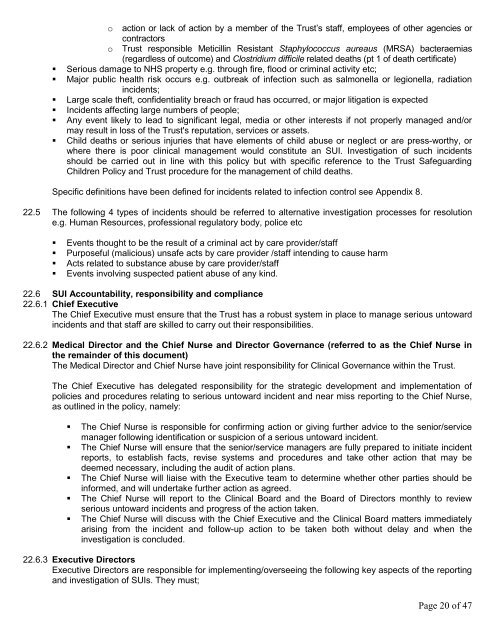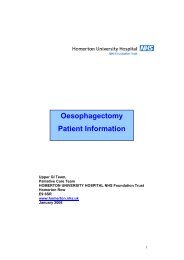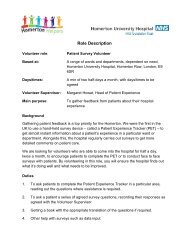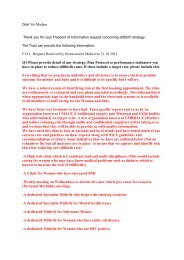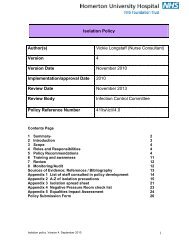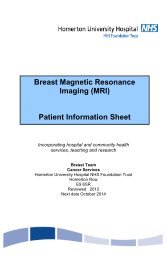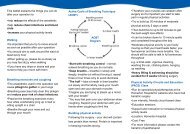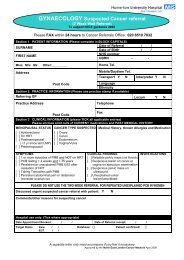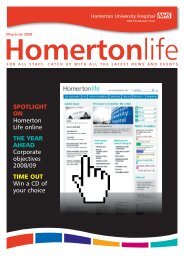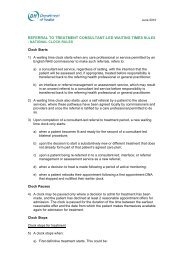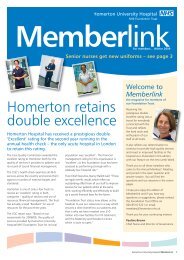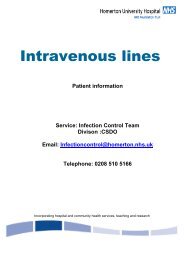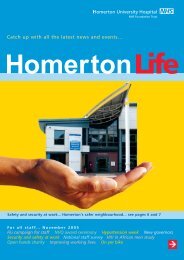Incident reporting policy - Homerton University Hospital
Incident reporting policy - Homerton University Hospital
Incident reporting policy - Homerton University Hospital
Create successful ePaper yourself
Turn your PDF publications into a flip-book with our unique Google optimized e-Paper software.
o action or lack of action by a member of the Trust‟s staff, employees of other agencies orcontractorso Trust responsible Meticillin Resistant Staphylococcus aureaus (MRSA) bacteraemias(regardless of outcome) and Clostridium difficile related deaths (pt 1 of death certificate)• Serious damage to NHS property e.g. through fire, flood or criminal activity etc;• Major public health risk occurs e.g. outbreak of infection such as salmonella or legionella, radiationincidents;• Large scale theft, confidentiality breach or fraud has occurred, or major litigation is expected• <strong>Incident</strong>s affecting large numbers of people;• Any event likely to lead to significant legal, media or other interests if not properly managed and/ormay result in loss of the Trust's reputation, services or assets.• Child deaths or serious injuries that have elements of child abuse or neglect or are press-worthy, orwhere there is poor clinical management would constitute an SUI. Investigation of such incidentsshould be carried out in line with this <strong>policy</strong> but with specific reference to the Trust SafeguardingChildren Policy and Trust procedure for the management of child deaths.Specific definitions have been defined for incidents related to infection control see Appendix 8.22.5 The following 4 types of incidents should be referred to alternative investigation processes for resolutione.g. Human Resources, professional regulatory body, police etc• Events thought to be the result of a criminal act by care provider/staff• Purposeful (malicious) unsafe acts by care provider /staff intending to cause harm• Acts related to substance abuse by care provider/staff• Events involving suspected patient abuse of any kind.22.6 SUI Accountability, responsibility and compliance22.6.1 Chief ExecutiveThe Chief Executive must ensure that the Trust has a robust system in place to manage serious untowardincidents and that staff are skilled to carry out their responsibilities.22.6.2 Medical Director and the Chief Nurse and Director Governance (referred to as the Chief Nurse inthe remainder of this document)The Medical Director and Chief Nurse have joint responsibility for Clinical Governance within the Trust.The Chief Executive has delegated responsibility for the strategic development and implementation ofpolicies and procedures relating to serious untoward incident and near miss <strong>reporting</strong> to the Chief Nurse,as outlined in the <strong>policy</strong>, namely:• The Chief Nurse is responsible for confirming action or giving further advice to the senior/servicemanager following identification or suspicion of a serious untoward incident.• The Chief Nurse will ensure that the senior/service managers are fully prepared to initiate incidentreports, to establish facts, revise systems and procedures and take other action that may bedeemed necessary, including the audit of action plans.• The Chief Nurse will liaise with the Executive team to determine whether other parties should beinformed, and will undertake further action as agreed.• The Chief Nurse will report to the Clinical Board and the Board of Directors monthly to reviewserious untoward incidents and progress of the action taken.• The Chief Nurse will discuss with the Chief Executive and the Clinical Board matters immediatelyarising from the incident and follow-up action to be taken both without delay and when theinvestigation is concluded.22.6.3 Executive DirectorsExecutive Directors are responsible for implementing/overseeing the following key aspects of the <strong>reporting</strong>and investigation of SUIs. They must;Page 20 of 47


